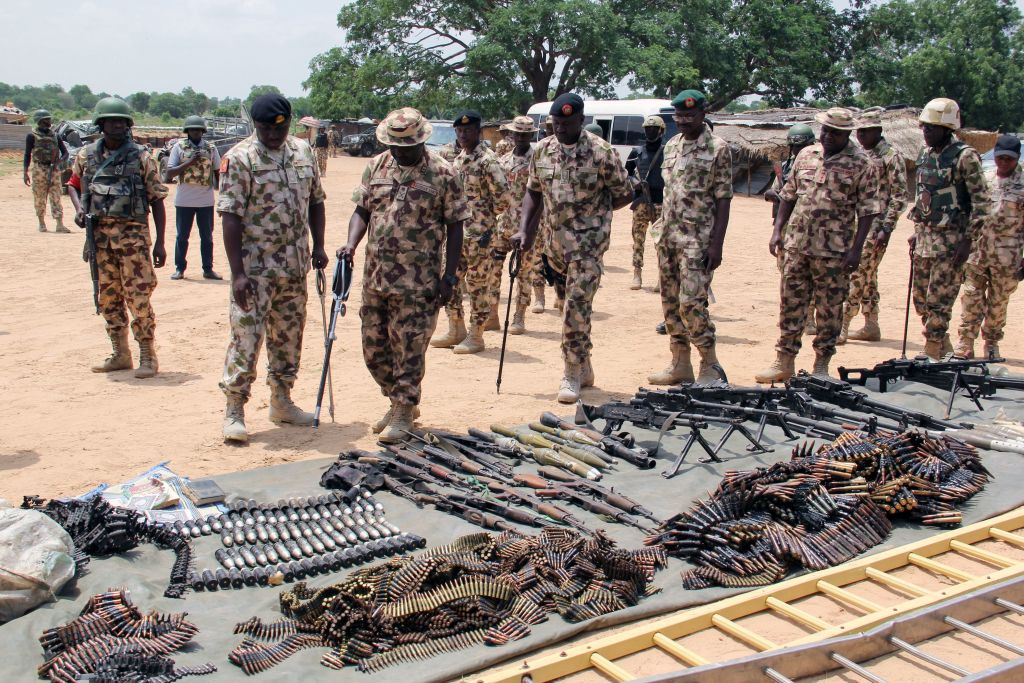Boko Haram and the Islamic State West Africa Province (ISWAP) used drones loaded with explosives when they killed 12 Cameroonian Soldiers and wounded 10 more in a March attack on a military base in the northeastern Nigerian town of Wulgo. The Soldiers were part of the Multinational Joint Task Force working to combat terrorism in the area.
Supply chains for such weaponry are limited in the Sahel, but terror groups linked to al-Qaida and the Islamic State group often use military weaponry seized during attacks on African militaries to perpetrate further violence.
This is according to a new report by Conflict Armament Research (CAR), which found no evidence that terror groups can access weapons such as assault rifles, battle rifles, grenade launchers, machine guns, mortars and rocket launchers directly from outside of the central Sahel. The United Nations has passed several mandates specifically prohibiting the sale or supply of weapons to countries in conflict or those with poor human rights records.
After the attack on Wulgo, ISWAP released photos of drones, bullets and machine guns it seized in the attack.
CAR’s analysis of weapons seized from Sahelian terror groups between 2014 and 2023 found that at least 20% of them were diverted from national militaries in Burkina Faso, Chad, Côte d’Ivoire, Liberia, Libya, Mali, Niger and Nigeria.
“These weapons allow Salafi jihadist groups to build their arsenals and reinforce their positions, thus enabling them to expand their authority over large portions of territory and increasing the threat to state authority and local communities,” the report said.
According to CAR, the arsenals of terror groups operating in the Liptako-Gourma tri-border region shared by Burkina Faso, Mali and western Niger and those in the Lake Chad region are similar. Assault rifles accounted for 78% of weapons recovered in the Liptako-Gourma region and 85% around Lake Chad. Most of the ammunition recovered from the groups was military grade.
Matthew Steadman, co-author of the CAR report, told Agence France-Presse the acquisition of military-grade materiel by Sahelian terror groups has created a “vicious circle.”
“As they become more powerful, as they seize more weapons, as they hit more outposts, then their ability to keep doing that increases exponentially,” Steadman said.
Another key source of weapons for these groups were firearms left over from previous conflicts, the report found. Terror groups in the Liptako-Gourma and Lake Chad border areas typically use decades-old assault rifles, particularly those manufactured in the 1960s and the 1970s. They commonly acquire so-called “legacy weapons” by accessing illicit weapon markets.
“Weapons that date back decades are still in service with several security forces in the region, meaning that some older items may have been diverted from state custody relatively recently,” the report said.
Sahelian terror groups typically maintain tight control of weapons they seize and do not routinely redistribute them. However, ongoing CAR investigations suggest that groups in the Liptako-Gourma area occasionally sell captured weapons for revenue, mainly in the form of gold. These funds help them pay militants or acquire supplies and equipment.
“Alongside booming local demand for small arms and light weapons, as well as a growing artisanal gold mining industry, this practice may lead to an increase in the illicit circulation of diverted government-issued weapons beyond Salafi jihadist circles,” the report said, adding that more investigations are needed to better understand the issue.
CAR found little evidence that ideologically aligned Salafi jihadist groups that operate in different regions — such as the Islamic State Sahel Province (ISSP) and ISWAP — share weapons with each other. In some cases, terror groups that battle one another — such as Jama’at Nusrat al-Islam wal-Muslimin, or JNIM, and the ISSP in the Liptako-Gourma area — have used weapons from the same series, indicating that they rely on similar procurement efforts.
Weapons produced and exported to the region after the 2011 fall of Moammar Gadhafi’s Libyan regime accounted for just 7% of weapons seized, according to CAR.
“Furthermore, CAR has not seen any evidence that Salafi jihadist groups in the central Sahel are systematically relying on long-range supply sources, including from Libya,” the report said. “Rather, weapons in Salafi jihadist holdings that originated in [Gaddafi-era] stocks were most likely sourced from local markets.”
However, the report showed that more than half of the small-caliber ammunition seized from Sahelian jihadists was manufactured within a decade of its recovery. Much of this ammunition was supplied to, and redirected from, central Sahelian militaries.

